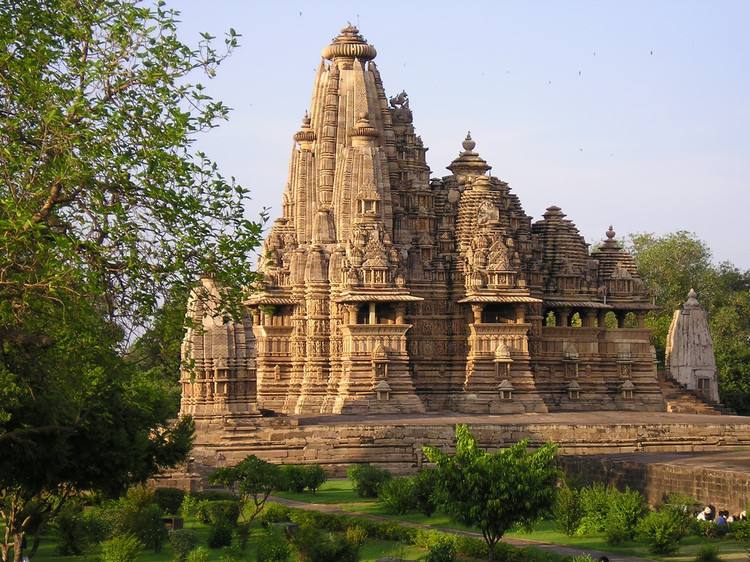World Heritage meaning
natural landscape. In a narrow sense, world heritage includes “world cultural heritage”, “World Natural Heritage”, “world cultural and natural heritage” and “cultural landscape”. In a broad sense, according to to form and nature, world heritage is divided into cultural heritage, natural heritage, cultural and natural dual heritage, memory heritage, human oral and intangible heritage (hereinafter referred to as intangible cultural heritage), and cultural landscape heritage.
| order | names | Place of ownership | introduce |
| 1 | The historic site of Khajuraho | India | The most interesting thing about Indian sex sculpture is that it is closely related to religion, so it is completely open. Anyone approaching the Khajuraho temple will immediately notice that the celebration of God and human sexuality is the core of the belief system of its builders. The appearance of a huge tower is decorated with stone statues of gods. The carving technique is exquisite and lifelike, which vividly reflects the tolerance and openness of Hinduism to human nature. |
| 2 | Rock-hewn Churches of Lalibela | Ethiopia | It is said that Lalibela, the seventh generation king of Ethiopia in the 12th century, got the oracle in his dream: “build a new Jerusalem city in Ethiopia and ask to build a church with a whole rock”. So, according to the Oracle, Lalibela used 20000 people to chisel out 11 rock churches in 24 years on the 2600m high rock plateau in northern Ethiopia. People call it liberal. Since then, Lalibela has become a holy land for Ethiopians. So far, every year on January 7, Ethiopian Christmas, believers will gather here. |
| 3 | Cologne Cathedral | Germany | Located in the central area of Cologne. The Gothic building was first built in 1248 and was built successively until 1880. Because of its uniqueness and creativity, Cologne Cathedral was listed as a world heritage site by UNESCO in 1996. Cologne Cathedral is famous for its lightness and elegance. It has become the symbol of Cologne City and one of the highest churches in the world. It was a magnificent memorial building built by the Germans at that time. Later, it became a symbol of the unity of religion, nationality, and art in Germany. Cologne Cathedral is the most perfect Gothic cathedral. It was built around 1248, with a height of 157.38 meters, a length of about 145 meters from east to west, a width of about 86 meters from north to south, and a construction area of about 6000 square meters. The whole building is made of polished stones. The construction of Cologne Cathedral lasted for 632 years. It is one of the longest buildings in the history of European architecture. It also has the simple style of the early Christian era. |
| 4 | The old city of Jerusalem and its walls | Jerusalem | Jerusalem is one of the oldest cities in the world, full of an Oriental cultural atmosphere. It is famous for being the holy land of Judaism, Christianity, and Islam. Over the past 3000 years, it has been continuously damaged and repaired in war and turmoil. It still shows the world a colorful appearance. Israel first established its capital here in 1000 BC. The temple built at that time was destroyed by the Roman invaders in the 7th century. After the subjugation, the Jews were forbidden to enter Jerusalem. After the 4th century A.D., it was allowed to go to the surviving residual wall once a year to cry and pray. Therefore, the residual wall was called the “wailing wall” by the world. On the slope inside the wailing wall, you can see a Rock mosque with a magnificent arch dome, which is the holy land of Islam. There is another one in the old city “Holy tomb cathedral” was built by the Romans for Christians in 327 A.D! |
| 5 | Historic Ensemble of the Potala Palace of Lhasa | China | There are many Buddhist temples and palaces in Lhasa, Tibet Autonomous Region. Since the 7th century, all living Buddhas have lived here. Lhasa has become the religious and political center of Tibet. On the red mountain in the northwest of Lhasa stands the world-famous Potala Palace. The palace stands against the mountain to the top of the mountain. Built-in the 7th century, this magnificent palace is a 9-story 1000-room palace built by Tibetan king Tubo to welcome Princess Wencheng of the Tang Dynasty. It is named Potala palace! It was recognized as a world heritage site in 1994. |
| 6 | Old Town of Hibam (Yemen) | Yemen | A group of high-rise buildings rising from the middle of the desert in the Arabian Peninsula gives people an incredible feeling like a mirage. The succinct appearance and the same shape are reminiscent of the skyscrapers in New York. These buildings with adobe as building materials are up to 30 meters high, which can indeed be called high-rise buildings in the middle ages. The origin of this high-rise building is the product of the traditional family system. At that time, after the family split up, they generally did not build new houses outside, but added floors on top of the original houses, thus gradually forming this kind of high-rise building. Each building has a 5-story or 8-story structure, with a total of more than 500 buildings and about 7000 residents. Most of the rooms on the first and second floors of the high-rise building have no windows (the first floor raises livestock, and the second floor serves as a warehouse), and more than three floors are for people to live. The roof and the attic are painted with alabaster. This kind of whitewashing actually protects the building. Imagine that without the annual whitening, the houses built 300 years ago might have been eroded away. Most of the existing buildings were built 100 or 300 years ago, and the oldest can be traced back to the 10th century. It was recognized as a world heritage site in 1982! |
| 7 | TheGiant’ScausewayandCausewayCoast | Northern Ireland | At the edge of the antling plain in Northern Ireland, along the coast, at the foot of the basalt cliff, the Cape of jaintscowsway, which is composed of about 40000 huge columns, protrudes from the sea. This famous scenic spot is like a legendary giant crossing the channel to Scotland. For 300 years, geologists have studied its structure and learned that it was formed by the continuous eruption of active volcanoes in the Tertiary period (about 50-60 million years ago). This scenic spot also promotes the development of earth science. In 1986, it was listed in the world heritage list according to the natural heritage selection standard n (I) (III) |
| 8 | The Terra Cotta Warriors of the first emperor of the Qin Dynasty | China | The mausoleum of the first emperor of the Qin Dynasty is the first imperial cemetery in China. It is the crystallization of the diligence and wisdom of the working people in China. It is a historical and cultural treasure house. Among the nearly 100 imperial tombs in China, it is famous for its large-scale and rich burials. In 1961, it was announced as the first batch of key cultural relics protection units by the people’s Republic of China; In 1987, it was listed in the world cultural heritage protection catalog by the United Nations Educational, scientific, and cultural organization and became the commonwealth of all mankind. The mausoleum of the first emperor of Qin was built in 246 B.C. at the beginning of the reign of the first emperor of Qin, which lasted 38 years and involved more than 720000 corvees and prisoners. This powerful monarch not only left great achievements for future generations but also left this mysterious Royal Cemetery. The mausoleum was built in imitation of the capital. The surrounding area of the mausoleum was in the shape of a circle. There were two walls inside and outside the mausoleum. The proven large-scale ground buildings were the base sites of the dormitory hall, the convention hall, the Garden Temple official house, and so on. It is located at the north foot of Lishan Mountain, 30 kilometers east of Xi’an. It is adjacent to Lishan Mountain in the South and the Weishui River in the north. Surrounded by towering peaks, the high mound is integrated with Lishan Mountain, with beautiful scenery and a unique environment. It was recognized as a world heritage site in 1987! |
| 9 | Rapanui’s famous resurrection Island Stonehenge | Chile | An isolated island in the South Pacific, 3800 nautical miles off the coast of Chile, covers an area of about 180 square kilometers. On Easter Day in 1722, the Dutch navigational Explorer Jacob roggwen landed on the island, so it was named Easter Island. It is speculated that in the 10th and 16th centuries, the aborigines on the island carved huge stone statues with human faces for the purpose of offering sacrifices to gods, which were 2-10 meters high and weighed 40-80 tons, with a total of about 1000 bodies. The eyes of these mysterious Moya stone statues with red hats were somehow dug out. Moya, who had lost her eyes, stood quietly on the island, looking up at space. It seems to be silently telling a distant story, leaving enigmatic mysteries and infinite reverie for future generations. It was recognized as a world heritage site in 1995! |
| 10 | Machu Picchu | Peru | Machu Picchu, known as the “city in the air”, is located at the tail of the Andes in southern Peru, at an altitude of 2430 meters. It is the largest Inca Empire site in South America. On July 24, 1911, with the help of Aboriginal guides, an American youth found the last urban site of the Inca Empire from the tropical virgin forest and revealed its secret to European and American society. The charm of the site also lies in the ingenious use of the mountain roots and the uneven terrain of the ground to achieve the perfect coordination between nature and architecture. It was recognized as a world heritage site in 1983! |
For reference only, please comment.







